A pictorial theory for a new social movement
Wednesday, July 12, 2023
In March 1992, my coauthor (Brian Willis) and I submitted a manuscript to Science proposing an expansive legal basis whereby public hospitals might sue the tobacco and alcohol industries for uncompensated healthcare costs using epidemiological evidence of corresponding commercial epidemics. I also sent copies of the manuscript to antitobacco activists, including Richard Daynard, who was inspired by the ideas to initiate the attorneys general Medicaid lawsuits, which ultimately led to the Master Tobacco Settlement. I proposed that public hospitals had legal standing to sue both tobacco and alcohol industries as “a plaintiff harmed by commercial epidemics”, as a way to protect vital societal infrastructures from all harmful commerce, but Daynard preferred to restrict attention to the tobacco companies. Dick Daynard shrewdly chose to use Mike Moore’s simpler and more straightforward legal theory based on the tobacco industry’s longstanding criminal wrongdoing, and, when I came to realize that my general and absolute approach to corporate accountability would have bankrupted large segments of the economy, I chose to step aside and fade into the background without taking credit for my contribution. Daynard and I met in person at his symposium in November 1995 discussing the attorneys general lawsuits, where he acknowledged to participants that the approach that my colleagues (Frank Vandall and Brian Willis) and I had published the preceding year in the Fordham Urban Law Journal was another valid implementation of third party litigation. I had always envisioned emulating living systems in my mathematical models, but it has taken me all these years to come up with a suitable theory.
After more than three decades of as-yet unpublished research, I have come up with another even more powerful idea, which could provide a pathway to absolute general corporate accountability for externalities — among other things with even wider implications. By contrast with my earlier idea, this one would be a much heavier lift, requiring new laws and a novel approach to governance, but as I’ll explain below, it could also unite disparate political factions in a common undertaking, as an antidote to our current polarization, tribalism, and incoherency. And as a mathematical antidote to chaotic tendencies, it also could defend our democracy and others around the world at a civilizational inflection point that demands wise and effective governance. I consider this initiative to be a long-term solution for current crises, achieving transformative ends instead of immediate fixes.
Background
Humanity now faces a different crisis, with externalities stemming especially from climate change, which I now propose might benefit from a modification of my earlier approach, whereby harmful industries should be held accountable only for externalities that encroach on the operation of vital societal infrastructures. This much more limited liability could serve as a segue to general and absolute corporate accountability within the civilizational biomimicry framework of a new economic theory I have developed, which is described below. To summarize this theory, markets are only the first, the lowest-level, and the least important of five lifelike economic engines, with others being 1. common interests, 2. physiological-like functions, 3. collective capabilities, and 4. emulation of human abilities at societal and civilizational levels. New laws and a new ethical framework tailored to our Anthropocene era could not only provide vital infrastructures reliable funding sources analogous to excise taxes but also offer corporations that currently impose negative externalities a pathway to becoming good citizens, repurposed to advance higher-level interests.
Introduction
In overview, my new idea centers around societal and civilizational biomimicry — proposing that governance should emulate life, in particular, choosing to imitate the most capable platform known, the human body | mind | and spirit — which makes the transition in embryogenesis to a multicellular system that cannot tolerate the physiological equivalent of externalities emanating from ongoing operations. As I will describe below, I have begun to sketch a mathematical model that views life and civilization as a fractal continuum from human physiology to collective capabilities to human abilities, as the basis for envisioning this biomimicry process, which would be characterized much more by cooperation than competition. Limited corporate accountability to vital societal infrastructures would become a transitional strategy for our civilization to develop the equivalent of metabolism, defined as advancing common interests | developing physiological functions | enhancing collective capabilities | and attaining human abilities. As the process becomes more and more successful at expanding collective capabilities to human-like attainment at ever-higher levels on that fractal continuum, most economic activity could shift from markets to the civilizational equivalent of metabolism, and corporate accountability could be broadened and deepened to eliminate all externalities.
The best dual argument in favor of my new theory is that neglecting it threatens to induce collapse, as unaccountable industries continue to become more and more toxic to human civilization, while adopting it will convincingly lead to transformative change at the crucial inflection point in our history when we most need wise and responsible self-governance. For example, imagine if news reports and social media posts, by reporters and politicians and citizens alike, were held loosely accountable, financially or otherwise, for social harm to common interests | collective capabilities | and civilizational biomimicry, as new mores developed to support the emerging civilizational metabolism. The unicellular-like chaos of our current political mess that is so toxic to our democracy would give way to an emerging multicellular-like sensibility emulating human abilities. As with spaceflight, technologies could enhance native abilities yet further — although we should avoid getting ahead of our skis and inventing a purely artificial life that lacks biological models. Best of all, embryogenesis provides an objective biological model how to implement this ongoing transformation.
It may seem utopian that we could change our whole approach to governance, but I argue that (1) conventional market-based economics is cynical, unsustainable, counterfactual, and dangerously flawed, (2) Trump supporters are painting themselves into a corner that will soon be perceived as indefensible, and (3) the younger generations, schooled under active shooter drills as their parents’ generation weakened gun laws and fanned the flames of firearms commerce, have already become politically active protesting climate neglect and abortion bans. Conditions are ripe for a tipping point that previously might have seemed inconceivable.
A pictorial “proof” of the theory
The simplest analogy for my theory is a 5-stage rocket putting a payload into orbit: the transformation of civilizational design to attain human-like abilities. This perspective shows how my theory differs from prevailing economic theory that only considers markets — which here are only the first of five booster stages!
Table 1. The multistage rocket booster analogy
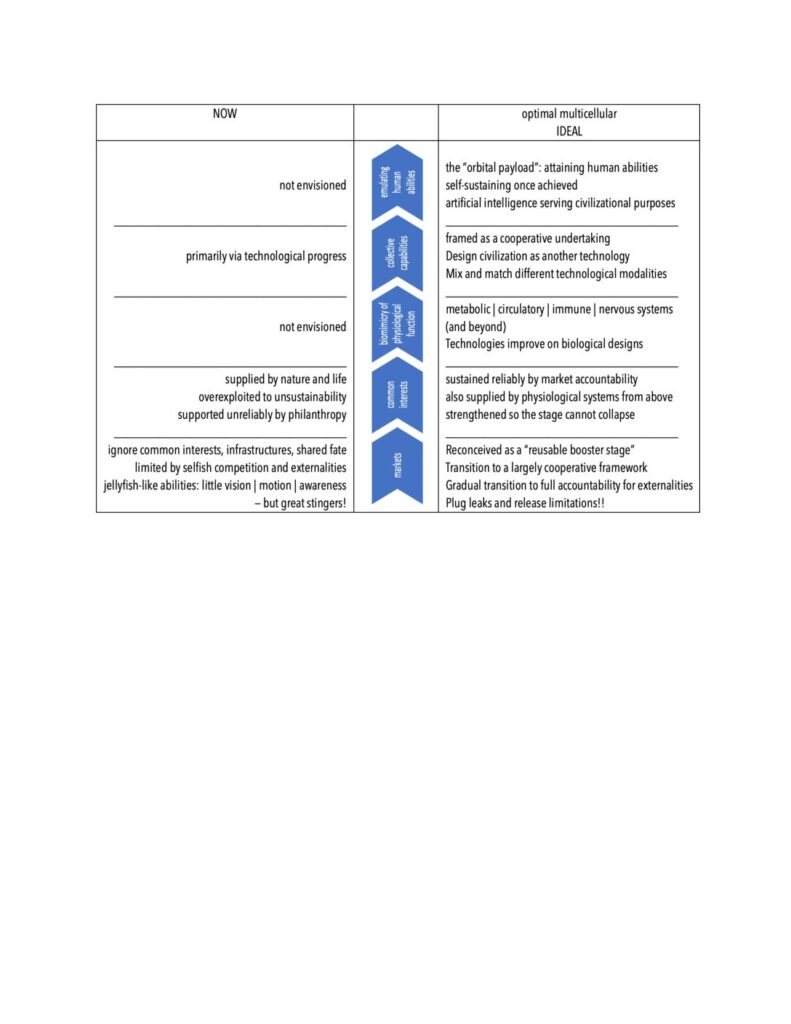
The multistage rocket analogy illustrates that the goal involves transformative, not incremental, change. It emphasizes that every stage must contribute to the whole undertaking, through cooperation instead of competition. Instead of markets, the focus shifts entirely to emulating human abilities at the civilizational level. Once that goal is attained, it should be self-sustaining — in large part because of all the advantages it will surely bring to living standards. Imagine establishing an ethical framework that brings to civilizational transformation all the capabilities of technological progress, applied to improving the design of human civilization itself. Such a framework would readily address all the major crises humanity currently faces — and then move on to extending and expanding transformative change indefinitely!
Next, let me proceed to specifics, presented here as a logical argument structured after a mathematical proof. You’ll notice that corporate accountability becomes a lemma, or intermediate result, of a broader picture of biomimicry.
Overview
- Fractals are scale-invariant structures, i.e., patterns that don’t materially change with different levels of organization over wide ranges. When fractal structure exists, we can compare processes that manifest over many layers of organization, like multicellular life extending to human abilities extending to collective capabilities emulating human abilities. My theory also considers gaps in fractal structure where that kind of organization hasn’t yet developed or after it collapses due to internal structural weaknesses.
- I’ll consider three types of fractals that illustrate different features of civilizational dynamics and development and might be applied in different developmental stages: (1) tree fractals that capture how life works to develop functional networks presented pictorially as optimization processes embedded in evolving systems, (2) Sierpinski fractals that identify how technology evolved through simpler operating modes that can be implemented as a transition, and (3) Koch anti-snowflake fractals that illustrate failure modes of existing technologies that explain how weak points can arise that may precipitate structural collapse and loss of all higher-level capabilities.
- This mathematical proof establishes a theoretical foundation for civilizational unfolding, which complements existing empirical disease classifications, catalogs of functioning processes, and historical databases of societal collapse and recovery.
- After the proof, I also consider the intermediate result of general corporate accountability limited to vital societal infrastructures, as a feasible fiduciary obligation that could be imposed by new laws and as a segue to absolute corporate accountability once higher-level interests get incorporated as driving forces in a more enlightened and lifelike economy.
A general theory of transformative capabilities: the tree fractal
- The most general model of life’s abilities is a tree fractal*, where higher levels are arranged above a trunk with markets at the lowest position (I don’t compare them to roots because the plant analogy does not fit with gaining human-like abilities). As with the multistage rocket analogy, the stages are 0. markets | 1. common interests | 2. physiological functions | 3. collective capabilities | and 4. attainment of human abilities.
* I thank Garrett Mitchener for suggesting tree fractals as the most direct example of the general theory.
Figure 1. A tree fractal depiction of the general theory of civilizational development and transformation.
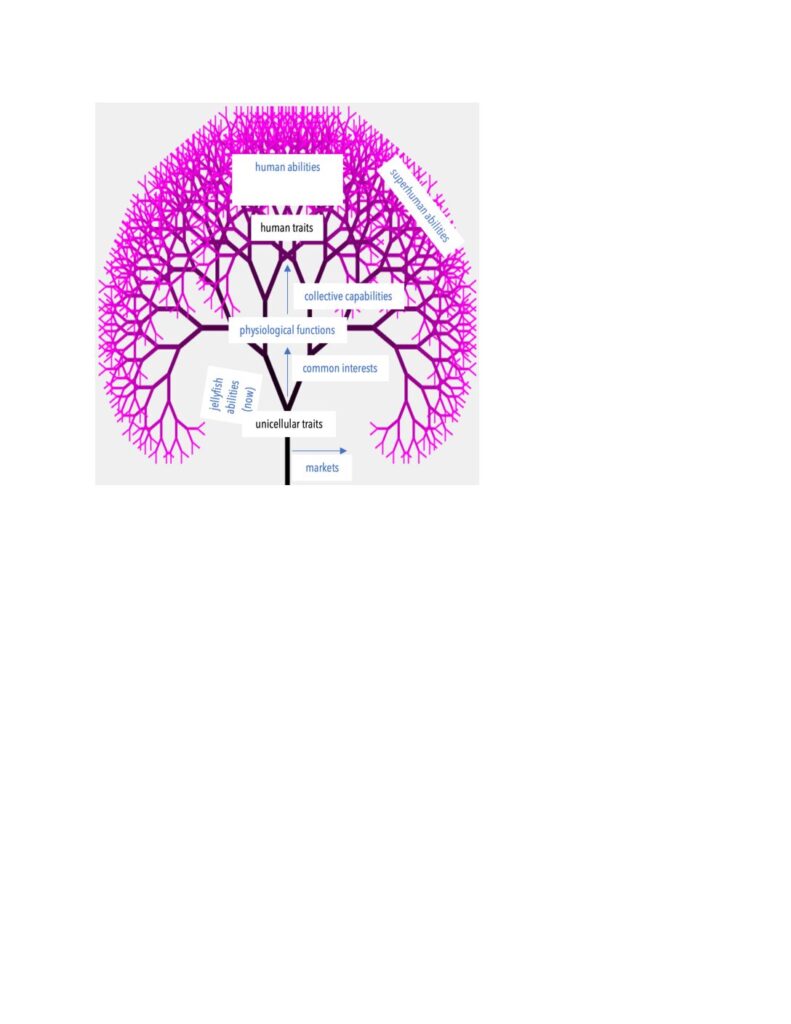
- Considering that developmental processes are evolutionary optimizations infusing negentropy into life’s designs, order the more developed implementations farther along the (primarily vertical) levels in the tree structure and more capable designs clockwise (primarily horizontally) along its outer branches.
- At each level, human abilities are oriented in the center and even more capable biomimicry designs (e.g., spaceflight) are displaced clockwise into yet higher branches, while the least capable designs (e.g., jellyfish) are clustered on the counterclockwise edge even below the lowest branches.
- Unlike the triangular fractal I will consider next, the tree fractal illustrates nicely that any functional network could be involved in the combinations of capabilities that emulate human abilities and that branching is not constrained to 3-step processes.
- The key to transformative capabilities of optimization processes is active elements, like transistors, which can serve as amplifiers in analog circuits or switching elements in digital applications. Fortunately, life resembles the most versatile electronic circuit element, the memristor, which can perform amplification and switching functions within the same circuit.
- The discoverer of the memristor, Leon Chua, has recently analyzed its application in complex combined electronic-diffusive systems, comparable to the dynamics of primitive organisms (like jellyfish) that process resources through diffusion rather than perfusion; the evolutionary emergence of circulatory systems greatly simplified logistic supply and conferred transformative capabilities to more advanced animals.
- Corporations, which have been conferred great power in markets, could be reconfigured as active elements within a perfusive circulatory system to address common interests and gain collective capabilities. Such repurposed corporations, perhaps functioning as cooperative institutions (co-ops) in synergy with societal infrastructures, could use their preexisting power for civilizational cooperation instead of market competition. The corporate charter for commercial enterprises that function solely in markets could be downgraded to reflect their more limited usefulness to society and civilization.
- Evolutionary life’s first venture past the jellyfish stage was the Cambrian explosion about 540 million years ago, which was a relatively sudden and extremely prolific experimentation with different body plans. Human society (very fortunately!) lacks the discipline of cells, which are programmed to commit suicide in place (apoptosis) when they deviate from their designated function. However, civilization has greater intelligence to bring to bear, especially with artificial intelligence soon to approach and exceed human abilities, along with greater inventiveness and purposiveness in engineering novel systems. Therefore, it’s reasonable to anticipate that the application of intelligence, inventiveness, and purposiveness would result in a sudden flood of insight, like the accomplishments of the Apollo space program applied to the civilizational equivalent of the Cambrian explosion, experimenting with body plans beyond the limitations of dyadic interactions, diffusive resource utilization, and an absent nervous system. Furthermore, human societies and civilization can emulate life’s discipline by simply changing behavior rather than undergoing apoptosis, as history has shown is the rule rather than the exception, as evidenced by cross-generational changes in moral views.
- When can we expect that civilizational signals can be amplified and transmitted digitally without distortion or loss from modules distributed throughout fractal networks? Probably only after deployment of a power supply/circulatory system, which depends on nationwide livable basic minimum incomes to cover living expenses for those who translate capabilities from one functional application to another without requiring remuneration for their efforts. Such living wages would also provide assurances that artificial intelligence would not displace human work and lead to high unemployment and widespread poverty. Salaries and immigrant wages could provide incentives for additional work beyond maintenance of the whole.
A transitional segue: the Sierpinski triangle fractal
- Recognizing that civilization must learn to crawl before we walk and walk before we run, it’s useful to examine where electronic devices were before active elements were invented: using resonant circuits and regenerative (passive) amplifiers, comparable to crystal radio receivers.
- Three-body problems of mutual interactions are notoriously chaotic, but as interdependence increases, stability improves when tribalistic interactions are replaced by separate involvements with the whole.
- Three- and four-step processes figure prominently in these restabilized processes, since they are complex enough to shape systems’ past | present | and future or to build three-dimensional structures. By contrast, two-agent interactions are prone to get stuck in competitive impasses and more than four steps again predispose to chaotic unpredictability. So, for example, cnidarians, typified by jellyfish, form from only two embryonic germ layers (endoderm and ectoderm, i.e., inside and outside layers) and are thereby limited to radial symmetry, while advanced metazoans, typified by humans, undergo embryogenesis involving three germ layers (endoderm, mesoderm, and ectoderm) and can form according to bilateral symmetry with greater capabilities, e.g., opposable thumbs.
- Comparable to fractals, Michael Lamport Commons has proposed a model of hierarchical complexity that spans 16 levels to handle algorithmic knowledge that progresses in developmental sequences, and his colleague Sara Nora Ross has speculated it has fractal structure.
- As a simpler analogy, consider Maslow’s hierarchy of needs as a motivational component of a single person’s behavior and then imagine further activity that extends beyond the individual in question. The gradation of needs defines levels of fractal structure for the next point.
Figure 2. Maslow’s hierarchy of needs.

- Now, instead of considering needs or algorithms, put intelligent agents (whether human or artificial) in each level to make decisions associated with the developmental processes at every level in the fractal, say, the way we elect political leaders in a democracy or the way people are hired to work in government agencies.
- Nature and (nonhuman) life typically form living structures according to the simpler 3-step processes, but humans and civilization are attentive to a fourth step: irreversible consequences of actions. For example, the problem-solving paradigm ubiquitous in human interactions involves the four steps
1. past: antecedents | 2. present: problems | 3. future: solutions | 4. irreversibility: consequences
The purpose of human activity often centers around shaping the irreversible consequences of human actions, i.e., to avoid regret from collapse and/or seeking the benefits of transformation.
- Shaped primarily by 3-step processes, the fractal must be a Sierpinski triangle. This fractal has rotational symmetry at 120° periodicities, suggestive of triadic resonant phenomena.
Figure 3. The Sierpinski triangle model.

As shown by the ellipses (…), the fractal pattern extends indefinitely in three directions from its leftmost edge (assuming that the structure is strong enough everywhere to resist collapse).
- The Sierpinski triangle fractal is formed by removing sections shaped like inverted triangles at each level of development.
Figure 4. Evolution of the Sierpinski triangle.

We can think of the omitted sections as being incompatible with multicellular life | human activity | and civilizational structure | shaped after human abilities, for example (respectively):
- past: residual harm from preexisting practices, e.g., competitive impasses (e.g., failures to cooperate)
- present: negative externalities, especially from harmful commerce
- future: immature forms that aren’t ready to accept responsibility (e.g., human institutions now!)
- irreversibility: weak inclinations that predispose to structural collapse
- Since the vertical axis of the Sierpinski fractal corresponds to organizational levels, as before, we can identify the different layers of civilizational “metabolism” on the diagram extending to ever-higher functionality:
0. markets (at the lowest level of each level, on the horizontal axis)
1. common interests
2. physiological functions
3. collective capabilities
4. emulating human abilities (extending the structure upward)
Figure 5. Civilizational development superimposed on the Sierpinski fractal model.

Note that the prevailing market economic theory only pertains to the lowest level and its horizontal axis, omitting all consideration of regret that may come from structural collapse and/or all benefits that may come from building higher structures.
As such, neoclassical economics is hopelessly inadequate for considering civilizational unfolding at this critical inflection point in human history.
By the same token, laws and government structures motivated by neoclassical economics are also hopelessly inadequate and dangerously unstable.
As multicellular-like economic interdependencies intensify into chaotic multi-body problems, competing firms must turn from dyadic conflict to separate involvements with higher interests for the whole. From there, triadic and tetradic dynamics become stabilizing.
Societies and civilizations currently have only rudimentary implementations of physiological functions.
- Proliferation of wastes in the environment provides evidence of poor recycling of resources.
- Persistent poverty provides evidence of poor circulation of resources.
- Presence of externalities from harmful industries provides evidence of poor elimination of wastes.
We need a word that indicates “support for the integrity of the whole”, as a new moral principle analogous to the dedication cells in a multicellular organism must exhibit for its body. I propose the term “proholian”, which is the opposite of “dysholian”. As development unfolds from bottom to top and left to right, each fractal module (triangle) manifests low performance at its leading (leftmost) edge and high performance at its trailing (rightmost) edge.
Consider how social phenomena might exhibit polynomial curves that motivate and generate development (or not!), superimposing the simplest plane-wave attractor-repellor locus on the fractal modules establishing their coalescing forces.
Figure 6. Dysholian and proholian force patterns.
a. dysholian force pattern, leading to poor performance: positive forces (attractor) at dysfunctional performance; negative forces (repellor) at functional performance
b. proholian force pattern, leading to good performance: negative forces (repellor) at dysfunctional performance; positive forces (attractor) at functional performance
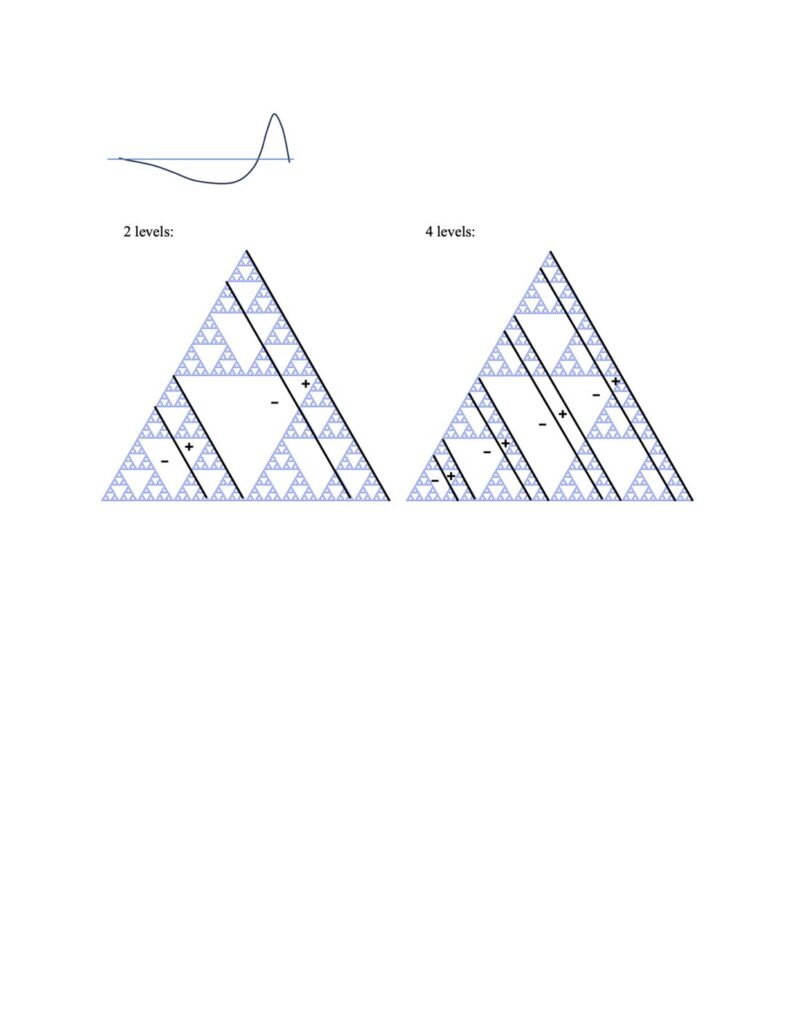
- Like the three germ layers in human embryogenesis, the three major political constituencies have specific roles to play in the development process:
1. reconciling the past: Disadvantaged populations play the role of mesoderm, fated to become the musculoskeletal system and internal organs, i.e., to shore up fractal structure and keep it from collapsing.
2. ministering to the present: Nurturant progressives play the role of endoderm, fated to become the gut, to manage resources prudently and sustain those who are alive at each point in time.
3. investing in the future: Cautious conservatives play the role of ectoderm, fated to become the skin and nervous system, eventually responsible for steering the whole organistic structure once it learns how to move (but not before developing universal empathy through many cycles of stubbing their toes!).
4. charting an irreversible trajectory: All three constituencies, through democratic concordance, plot the system’s path that determines their shared fate.
- Civilizational unfolding = civilizational dynamics | development | design | and transformation.
- Consider the forces of nature and life that shape civilizational dynamics, in 3-step processes setting up visible spatiotemporal waves and trajectories involving hydrodynamic quantum analogs**:
** Details are outside the scope of this presentation. Note, however, that this perspective suggests a mathematical foundation for evolutionary processes, including natural selection under Darwinian evolution, which has not previously been described.
Figure 7. Forces exerted by nature and life on civilizational dynamics.
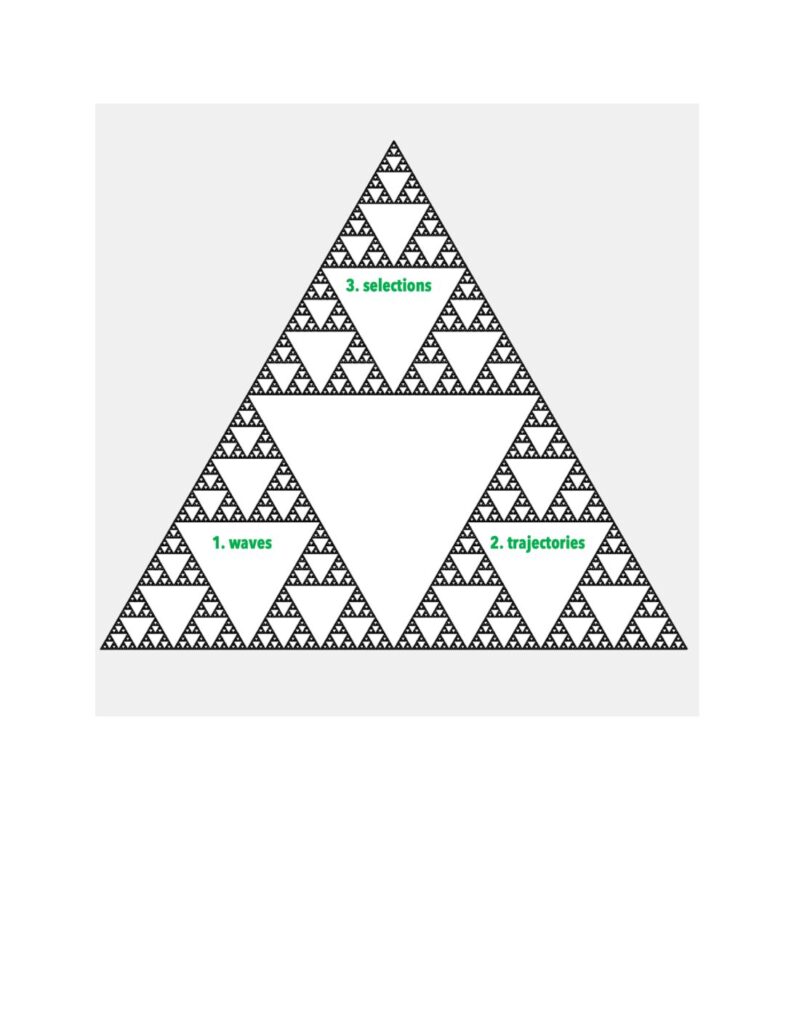
- Now consider two 4-step problem-solving processes and a final 1-step process that represent how human civilization deals with its challenges:
Figure 8. Forces exerted by human effort on civilizational dynamics.
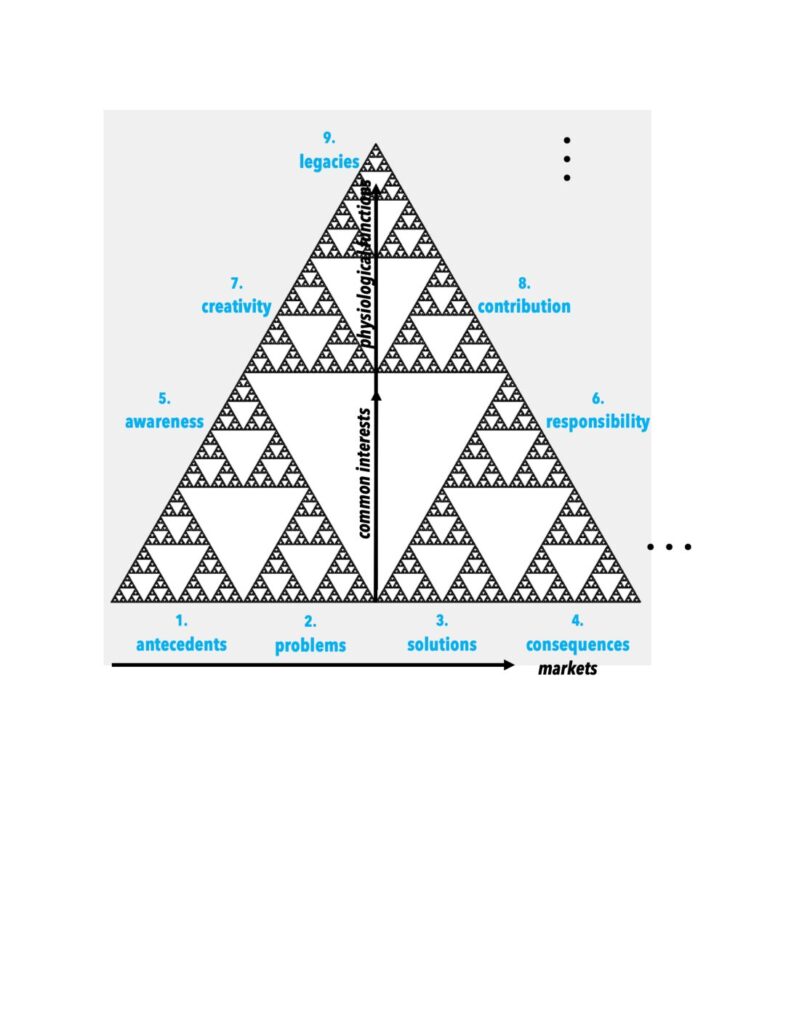
in markets: 1. antecedents | 2. problems | 3. solutions | 4. consequences
in civilizational unfolding: 1. awareness | 2. responsibility | 3. creativity | 4. contribution
for generativity (passing insights and innovations to future generations): legacies
Features of this Sierpinski triangle fractal:
- We’ve seen how the same diagram maps motivations, forces, and developments onto the same Sierpinski triangle fractal.
- Overall health of the entire structure is determined by its strength (resistance to collapse) and interrelationships among fractal modules that affect its innovation (propensity to transform).
- Intermediate levels of common interests are prerequisites for building collective capabilities. Our civilization is notorious for neglecting common interests.
- Since nature and life operate in parallel with human activity, we must respect their rules, lest common interests and collective capabilities exhibit weaknesses that can cause the whole structure to collapse, forfeiting all collective capabilities above that level.
- Next, we introduce another fractal model of structural weakness, the Koch anti-snowflake, to illustrate processes that can lead to collapse.
A potential pitfall: internal damage that can precipitate structural collapse: the Koch anti-snowflake
The next figure contrasts the growing Koch snowflake fractal with the eroding Koch anti-snowflake fractal.
Figure 9. The Koch snowflake and the Koch anti-snowflake.
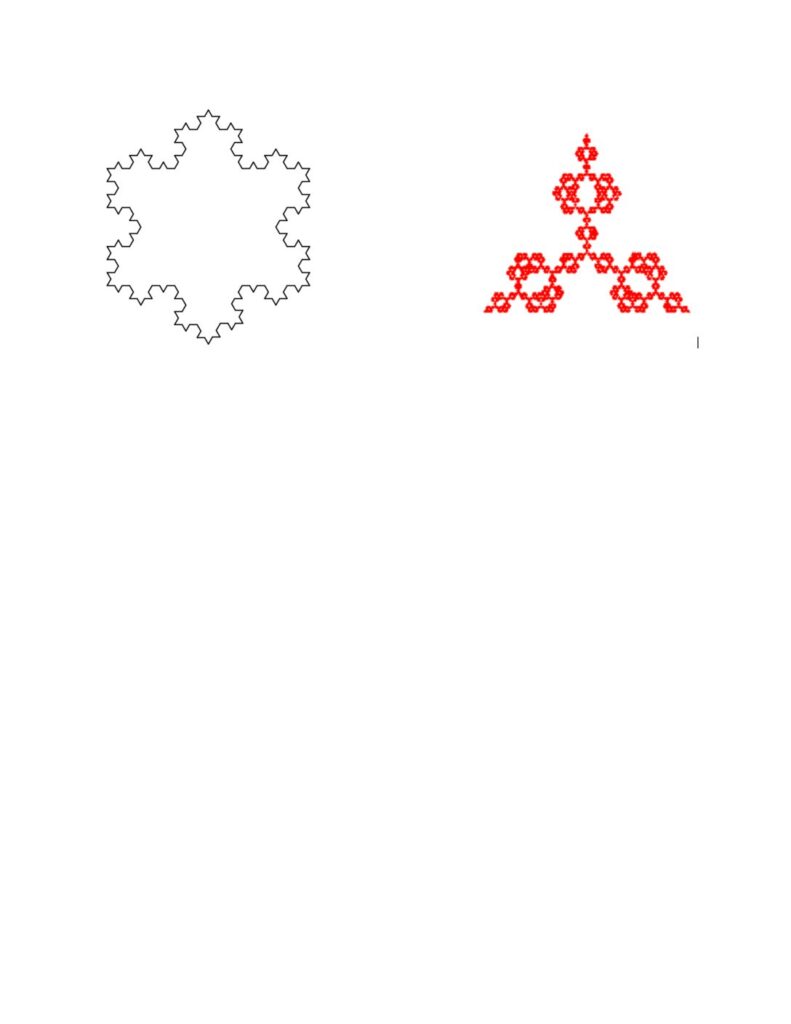
The Koch snowflake grows with each step. The Koch anti-snowflake erodes with each step.
Fractal modules damaged via this erosion failure mode may be unsuitable for subsequent growth and development.
Growth and erosion processes coexist, strengthening some parts and weakening others, even within the same cell.
Figure 10. How early erosion can damage a mixed fractal to create a weak point.

A mixture of both processes shows how erosion can create separated islands that become weak points.
This leads to a danger of higher-level collapse that economists don’t currently consider.
Color damaged cells in a temperature scale in the tree or Sierpinski fractal, in proportion to their damage.
Figure 11. Damaged fractals of varied severity depicted on a tree fractal and a Sierpinski triangle.

The structure becomes weak and unstable above this damage, unsuitable for development of collective capabilities.
With collapse, all higher capabilities get lost. This problem is worst for early developmental stages — like now!
More detailed multidimensional catalogs of system weakness and dysfunction could be taken from function and disease classifications, e.g., the International Classification of Diseases (ICD) and the more expansive International Classification of Function, Disability, and Health (ICF). In addition, theoretical biologist Peter Turchin has developed cliodynamics, an empirical approach to a science of history based on past experiences that led to societal collapses.
In summary, this pictorial tour of the fractal mathematics of civilizational unfolding portrays a much more nuanced picture of the dynamics | development | design | and transformation of human civilization than is specified by our current economic and political systems, which can be clearly identified as dysfunctional and dangerously unstable subsets. The tree fractal captures the most general features of the theory based on what life can accomplish, fully embodied when networks can be implemented with active (amplifying and/or switching) elements. The Sierpinski triangle fractal considers simpler forms based on how electronic technologies evolved, through a passive implementation attained through resonant circuits and passive regenerative amplification, which in the civilizational case could be obtained through cooperative recruitment of higher-level interests. The Koch anti-snowflake fractal illustrates where we are now based on failure modes of existing technologies, which explain how weak spots can develop, especially early in system evolution, predisposing to structural collapse that can result in loss of all higher capabilities.
Application to corporate accountability
Here is where we begin discussion of corporate accountability. As explained below, this perspective is a work in progress rather than a dogmatic prescription of some idealized implementation:
- A unicellular form can sustain externalities of ruthless competition, but as an embryo progresses to multicellular form, it can no longer tolerate encroachment on common interests, collective capabilities, and/or the organism’s shared fate. A multicellular organism cannot leave parts of its body to fend for themselves lest necrosis sets in, potentially inducing lifethreatening systemic sepsis. As the embryo develops a circulatory system, it potentiates an immune system’s responsiveness and power. Perfusion sustains cells much better than the diffusion processes that preceded emergence of the circulatory system — a powerful argument for the most progressive of policies, the basic universal income, completely apart from consideration of political ideologies. If all people are supported in the manner of systemic circulation and cellular perfusion, nobody has to work for harmful industries. It’s more important that economic activity not encroach on operation of the whole than that everyone have make-work employment. However, that endpoint is not workable until the system starts functioning as a whole. During the transition period, it will suffice for harmful industries to pay related infrastructures in proportion to their encroachment on infrastructure function.
- During the transition to multicellular operation, societal infrastructures need reliable funding, to prevent collapse from occurring. I propose that harmful industries that encroach on the function of infrastructures building higher-level function have a fiduciary accountability, like a directed excise tax that assures a reliable funding source. This arrangement emulates changes in an embryo that allow it to make the transition to multicellular life.
- From a practical standpoint, this shift to limited corporate accountability might correspond to government relying less on a universal system of personal income tax and more on directed corporate funding. Since externalities are large compared to tax revenues, we might envision a society where only the very rich pay income or wealth taxes, harmful corporations pay most of the taxes, and beneficial industries and most individuals receive subsidies.
- Such arrangements would also establish a “proholian” ethic that must permeate a society and civilization as technologies become ever more powerful and more flexible, to prevent them from also becoming more toxic to society, civilization, and the planet.
- Case study 1. Nuclear energy. Safe nuclear fission power is possible using liquid sodium cooling in breeder reactors. Such reactors can also use plutonium as fuel, essentially consuming a toxic radioactive waste with extremely long half-life, effectively circumventing an intractable waste storage problem. However, such a potentially toxic technology should not be considered as a market in the business of generating revenues, but rather as an infrastructure serving the public interest. Effectively, this technology’s activities should be redirected from the horizontal to the vertical axis, to address common interests, develop collective capabilities, and emulate biological functions. Thus, nuclear fission energy might be envisioned as supplementary to renewable power sources in the short run and ultimately replaced by nuclear fusion energy. Markets could not manage that transition without externalities and toxicities, but common interests and collective capabilities can.
- Case study 2. Artificial intelligence. Recall that the Sierpinski fractal is a series of processes on a developmental continuum, into which we put intelligent agents to manage those processes. One of those agents could be artificial intelligence. When AI is redirected to civilizational design in the public interest, we might find its character change from an existential threat to a boon to humanity. And where residual externalities remain, fiduciary corporate accountability could provide funding for ameliorating the harm, finding corrective solutions, and designating corrective infrastructures.
- Case study 3. Firearms. The firearms industry has marketed the most inherently dangerous consumer products so aggressively as to have precipitated an existential crisis in American society, invading it with assault weapons and tactical gear, creating an epidemic of mass shootings, and threatening our nation with civil war. We are witnessing a slow-motion cross-generational oscillation, where “the greatest generation” utilized the arms industry to wipe fascism temporarily off the face of the earth but “the worst generation” that followed (mine) has used guns to reintroduce fascism directly back into the United States; it will be up to the subsequent generation, left vulnerable to school shootings during their childhoods, to make amends for their parents’ neglect and indifference. The invasion of deadly firearms into civil society has inflicted damage on the fractal modules of the social structure that cannot be allowed to persist, lest they precipitate collapse and loss of higher-level capabilities, e.g., because of civil war. I envision a proholian ethic emerging that will make firearms extremely uncool, to the point where those who inherit them will not even require buyback programs to submit them for destruction. However, in the meantime, the firearms industry can be held accountable for the costs of hardening schools and other public gatherings against mass shootings, as well as the grief and psychological counseling costs of injured victims and shooting survivors, closing those externalities and making them a cost of doing business for firearms manufacturers.
- The details of corporate accountability might be expected to undergo rapid changes, consistent with how the appearance and function of embryos change rapidly during gestation. Furthermore, we would expect that current approaches that are consistent with the unicellular-like design of society and civilization might no longer work during transition and transformation toward multicellular-like operation. As a result, we shouldn’t get preoccupied with the specifics of such details. In other words, even though parts of the above description might sound foreign to us now, part of that discord may originate from our current unsustainable approach and another part from the moving target of embryogenesis.
Embryogenesis provides an objective gold standard for implementing these changes. We will have to be flexible in applying this model. It will take time to sort out when embryogenesis ends and some free-living state begins, at which point the model will shift again to childhood development. Humanity can apply reason to steering a societal and civilizational trajectory during those early developmental stages.
Outline of my future plans
I have worked resolutely for 31 years to develop these ideas, which I have presented above as a pictorial “proof” of the possibilities and pitfalls of civilizational transformation. I am in touch with the Deep Transformation Network and envision starting a social movement to redefine the human economic system in terms of higher-level interests. I have been out of an academic environment working on these matters independently, but I’m recontacting universities that have been involved at one time or other to reestablish my scholastic credentials.